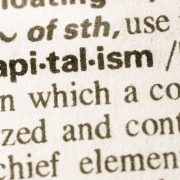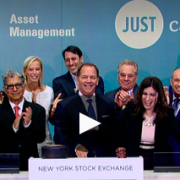Many critics of capitalism have given up trying to claim capitalism makes people poorer. Faced with so many obvious gains in the standard of living, and in reducing poverty worldwide, markets have won the economic debate over whether or not capitalism is the path to material riches.
But the doctrinaire anti-capitalists have other strategies. They’ve now branched out into blaming capitalism for a host of other social, ecological, and psychological ills.
Sometimes, the tactic is to blame capitalism for destroying the earth. Other times, it’s to claim that capitalism, in spite of the material plenty it delivers, makes us miserable.
For example, George Monbiot, columnist at The Guardian blames pro-capitalist ideology for making people, sad, lonely, and unhealthy. Writers cite polls claiming people in richer countries — i.e., more capitalistic ones — are more miserable than people elsewhere. Holly Baxter at The Independent suggests capitalism is the reason elderly people are now so lonely and isolated: capitalism makes us more concerned with buying things than with visiting poor, dying Aunt Ethel.
Claim: Capitalism Wants Us to Be Sad, Needy Consumers
And it’s all by design, it seems. According to Monbiot and other critics of “neoliberalism” — by which they just mean anything resembling a market system — the capitalist ideology is designed to isolate us, and turn us into soulless consumers. This then paves the way for an endless cycle of misery and consumption.
For a more academic phrasing of this idea, we could consult Ankita Singh’s article “Capitalism, Consumerism, and Popular Culture” which examines how capitalism creates a downward cycle of despair. This persistent unhappiness, Singh explains, “is caused [by] the sense of alienation one feels in today’s urban corporate culture.” Consequently, consumers attempt to “compensate” for their capitalism-caused “emptiness” by “indulg[ing] in inanimate objects offered by the consumerist culture.”
At this point, all that is left for the capitalists to do is to tell us what products to buy. And fortunately for the capitalists, Singh tells us: “The power of advertising is such that it can create a demand where none exists, of a commodity which is not needed.”1
Much of this general concept can be traced back to Marxist psychologist Erich Fromm, who in Escape from Freedom (1941) wrote:
In capitalism economic activity, success, material gains, become ends in themselves. It becomes man’s fate to contribute to the growth of the economic system, to amass capital, not for purposes of his own happiness or salvation, but as an end in itself.
That is, through capitalism and its propagandists (i.e., advertisers) human beings are reduced to “a cog in the vast economic machine” who no longer pursues his own happiness, but only serves the interests of “capitalism.”
There are a couple of problems with this theory, though.
One is that a capitalist economy does not rely on endless consumption to sustain itself. The second is that advertising doesn’t work the way many assume it does.
Capitalism Doesn’t Cause Consumerism
For starters, it is not the case that the capitalist system is built on consumption or that it requires us to mortgage our future in order to buy ever-larger amounts of consumer goods. After all, it is for a good reason that capitalism has historically been much associated with misers — the quintessential literary example being Ebenezer Scrooge — who shunned consumerism. Saving (i.e., deferred spending) is every bit as essential to capitalism as is consumption. It is governments and their central banks, not markets, that seek to maximize consumption always and everywhere.
Moreover, saving and investment are key ingredients in increasing wages, growing the capital stock, and increasing future consumption. In a market economy, many firms, such as retirement funds and banks, directly profit from more saving and investment.
Spending every last dime on another trinket or bauble is not a recipe for robust capitalism.
How Advertisers Are Supposedly Making Us Miserable
At this point, the purveyor of the capitalism-makes-you-sad theory could still insist: “sure, maybe capitalism overall doesn’t require us to relentlessly consume. But certainly there’s a portion of the capitalist system, such as toy sellers and auto makers, who need us to consume. And to get us to do so, they use advertising designed to keep us hoping we can fill that hole in our souls with just one more trip to the mall.”
There’s a (small) kernel of truth to this. Many capitalists do indeed want us to buy consumer goods, without much regard to the consequences to each consumer personally. In hopes of getting us to spend, they employ advertising. And advertising often promotes feelings of inadequacy to get us to consume more.
This particular kind of advertising was developed at least as early as the nineteenth century. It was then perfected in the 1920s.
Typical examples of the formula include:
- Why be ugly … when you can use Zenith Cold Cream?
- Why be fat … when you can take Acme Diet Pills?
This formula was so widespread by the 1920s and 1930s, in fact, that Sigmund Freud joked the “boldest and most successful piece of American publicity” would be an ad using the phrase “Why live if you can be buried for ten dollars?”2
Nowadays, a lot of modern advertising is more nuanced and less in-your-face than this formula. Modern advertising often appeals to humor. Nevertheless, advertisers nowadays still rely on the strategy of presenting consumption as a sort of self-improvement. They offer a glimpse of a life of better looking people, more luxurious cars, and more fulfilling friendships. It’s the life you might have if you only consume the right products and services.
But do people actually believe what advertisers tell them?
Clearly, people don’t buy everything advertisers tell them to. If they did, as Ludwig von Mises noted, candle makers could convince us to abandon light bulbs with a few ad campaigns.
Indeed, studies conducted to determine the effectiveness of ads have never been conclusive. A 1931 consumer survey revealed the “only 5 percent of the public believed any of the more obviously outrageous claims made by ads.” Only 37 percent believed any ads at all.3
A 2013 survey concluded only 21 percent of consumers agreed “ads are somewhat accurate.” 21 percent also said they will even “refuse to purchase products due to brand advertising.”
Some might claim this is only survey data, and thus questionable. But then there are countless cases in which ad campaigns failed to achieve results. A 2015 study from the University of Texas, for example, showed alcohol ads have increased 400 percent over the past forty years. Meanwhile, per capita alcohol consumption has gone down. Yes, advertising can be helpful in promoting a certain brand. But it hasn’t been shown to increase a person’s overall spending.
So, it seems people don’t spend more just because capitalists tell them to. And its unclear that many even believe what ads have to say. If this is the case, it’s hard to see how “capitalism” has succeeded in its nefarious plan to make us miserable consumers, assuaging our loneliness with another round of mindless spending.
Are We More Miserable than Our Forebears?
In spite of the unconvincing reasoning behind the capitalism-makes-you-sad narrative, many continue to find it plausible. This is largely because many people remain convinced that people were happier — or at least had an easier time — in the past.
Certainly, there’s no statistical data to support this. Those happiness measurements we sometimes read about in the popular media (such as this one) are usually based on totally subjective self-reported survey data and offer absolutely no means of comparing the present with the past. Attempts to systematically asses “happiness” in the past were virtually nonexistent.
Quality-of-life indicators reconstructed from the past (such as working hours, living space, life expectancy, and homicide rates) don’t often make the era of our grandparents or great-grandparents look especially wonderful. The nineteenth century — an era before modern methods of mass marketing and mass consumption — wasn’t an era of carefree indifference to the requirements of daily work and toil. The poverty of the “good old days” was not exactly a source of personal fulfillment and contentment.
But perhaps we need to look deeper into the past?
On this, Murray Rothbard suggests the imagined Golden Age before capitalism existed. It was, according to the myth, an era of “Happy Craftsmen and Happy Peasants” who had a “sense of belonging” and all were “sure of his station in life.” No one suspected he ought to be buying a new car or a new bedroom set. No such options were available at all.
Was living in poverty with no access to advertisements or capitalism the real key to happiness? Rothbard is skeptical and notes that people — should they really want to flee capitalism — are largely free to pursue this supposedly happier type of living in communes like the utopians or hippies of old. He concludes:
Not only has almost no one abandoned modern society to return to a happy, integrated life of fixed poverty, but those few intellectuals who did form communal Utopias of one sort or another during the nineteenth century abandoned these attempts very quickly. And perhaps the most conspicuous nonwithdrawers from society are those very critics who use our modern “alienated” mass communications to denounce modern society.
It’s comforting to think there is some time or place in which human beings were not troubled by feelings of unhappiness, emptiness, or inadequacy. It’s unclear, however, where or when this place has existed. In the meantime, few seem willing to give up their modern amenities to investigate first-hand.
Ryan McMaken (@ryanmcmaken) is a senior editor at the Mises Institute.
- 1.Singh calls to mind a line from the 1999 film Fight Club in which a main character declares modern workers in a capitalistic system are “slaves with white collars. Advertising has us chasing cars and clothes. Working jobs we hate so that we can buy sh-t we don’t need.”
- 2.Ann Douglas, Terrible Honesty:Mongrel Manhattan in the 1920s (New York: The Noonday Press, 1995), p. 144.
- 3.Ibid., p. 68.













